Advances in Digital Learning and Development
Task 1
Impact of technology and collaboration with digital tools on the design and delivery of learning and development over the past five years (AC 1.1)
Slide 2
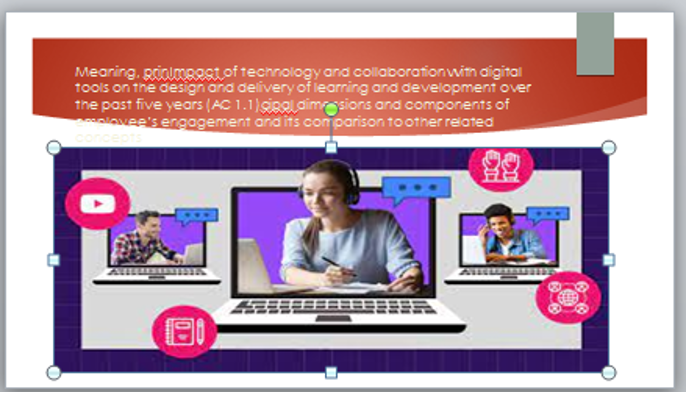 Better engagement
Better engagement
The scope of engagement among learners is unlimited in the case of technology along with digital collaboration. Unlike the traditional education system, technology along with digital collaboration has been facilitating a more comprehensive range of learning designs and delivery of learning through virtual reality, interactive sessions, availability of unlimited content, among others. As a result, technology has become a powerful tool that has not only encouraged better engagement but has also transformed learning in several ways, making it easier and more engaging for teachers. In addition, technology has been instrumental in bringing learners together through collaboration tools and discussions.
Extensive learning opportunities
The most significant advantage of development and digital collaboration in the design and delivery of learning has been extensive learning opportunities. Over the last five years, learners have learned several new things, unlike they did with the traditional learning system due to the availability of learning tools. The development of technology and digital collaboration has also created opportunities for communication and collaboration among learners. Learners can share what they know with other learners in the same course using digital tools such as Google docs and wikis. Unlike traditional education systems, technology has enabled the new design and delivering learning. Learning institutions have been redesigning their learning spaces to accommodate the new model of education to foster more interactions among learners who have been taught to use technology as an enabler.
It makes learners acquainted with digital technologies and tools.
The development of technology and digital collaboration has successfully exposed learners to digital technology tools that have prepared them for higher education and modern careers (Odinokaya, Krepkaia et al., 2019). Additionally, it has equipped them with various skills that make them acquainted with the digital world. The rise of accessibility of digital technologies and tools has been opening doors to a high number of students populations who were previously left behind. The ability to access learning materials in multiple formats and participate in various channels has also enabled learners with a disability to advance their education with limited challenges.
Creative collaborations and learning experiences
Apart from making education accessible to learners with disabilities, technology and digital tools have also been opening doors to learners who would be previously unable to afford their education. Distance learning and e-learning through the use of digital tools has positively impacted many students to advance their education despite their geographical distance and accessibility of more income, it is more affordable and flexible.
Improved teaching operations that facilitate efficiency, collaboration and diversity
Over the last five years, tutors have been incorporating online collaboration tools and course management tools to organize learners’ materials and give them feedback. Technology and the collaboration of digital tools have made it easier for tutors to keep track of their learner’s performance data and evaluate their trends over time. Technology has also been efficient for tutors as it makes them use computers remotely to solve their challenges rather than spend more time in the classroom trying to figure them out (Stenman and Pettersson, 2020). This is mainly because technology offers a wide range of learning information at a click of a button.
-
Risk and challenges that technology-based learning and development pose to:
Organizations, and how these could be addressed (part of AC 1.2)
Slide 3
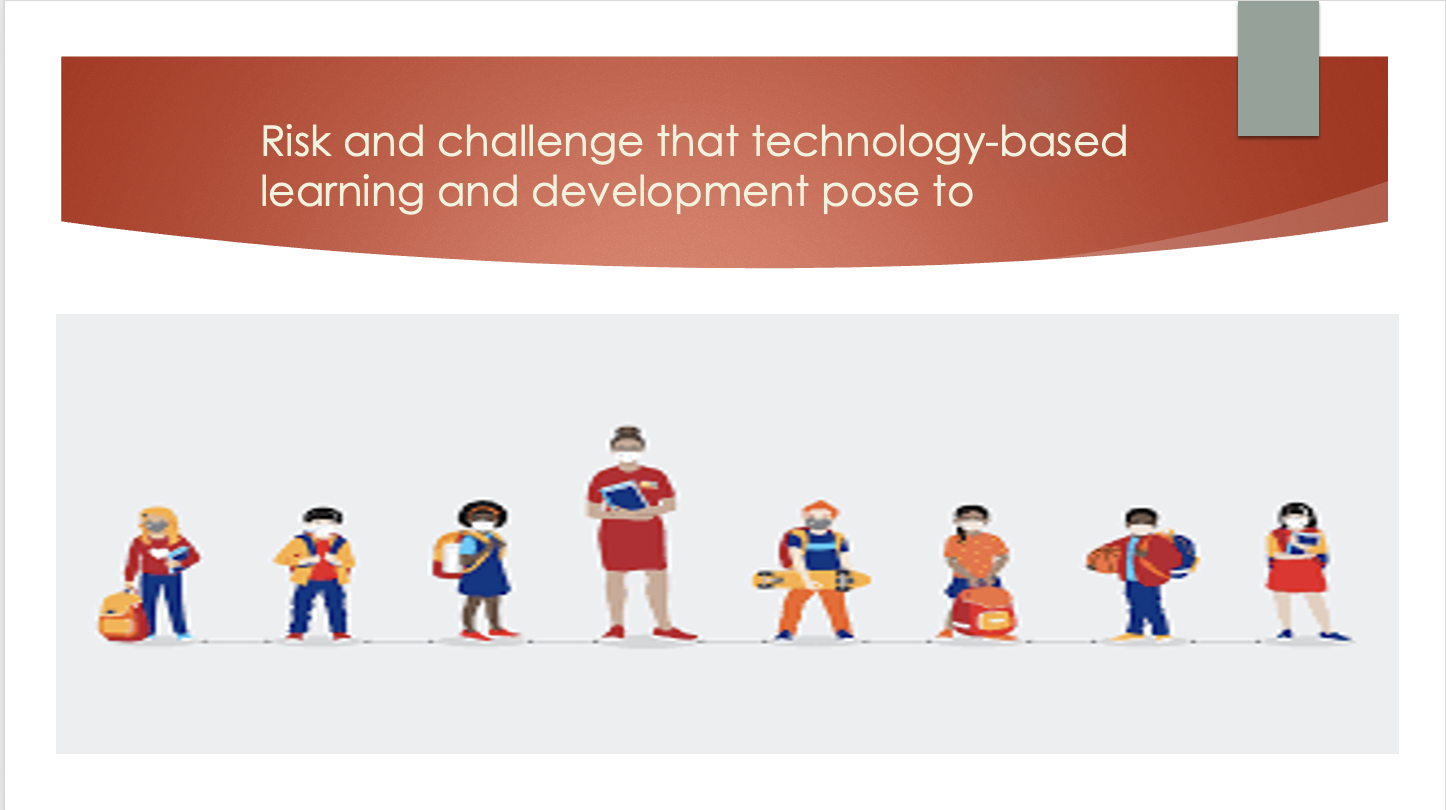 Information technology risk
Information technology risk
Information technology plays a vital role in the organization. Information technology risk is any risk related to information technology in the organization. The rise of technology-based learning and development has led many organizations to depend on technology to process their information. IT risks cause harm to the organization as it exploits the vulnerabilities of assets. IT risks posed to the organization by technology-based learning and development are software and hardware failure, viruses, and malicious attacks on the system of the organization. However, the firm can address these risks by conducting a business risk assessment. Additionally, having a business continuity plan will also help the firm recover from the IT incident.
Data security
Due to technology-based learning and development, organizations face data security as a significant challenge (Caputo, Garcia-Perez et al., 2019). The high amount of business data stored and transmitted electronically has been causing data breaches in most organizations. However, data security can be solved through regulations that raise standards of data security practices. It can also be addressed through encryption and biometrics to facilitate accountability of these data.
- L&D professionals, and how these could be addressed (part of AC 1.2)
Extensive use of technology for assessment
Extensive use of technology might result in L&D professionals using standardized questions and answers. However, since the ability of computers to judge essays remains underdeveloped, L&D professionals should encourage their learners to be more creative and not rely on computers for answers.
Engaging learners in the new technology
L&D professionals often find it challenging to engage and communicate the value of learning and developing top learners. In addition, professionals might find it challenging to get all learners onboard into the new technology, which might also be costly. Professionals are also often faced with the higher cost of bringing the new technology into the classroom. Additionally, the technology might also misuse the technology during the learning and development session. L&D professionals can, however, address this challenge by allowing learners to express their concerns and setting clear expectations for those who will use the new technology.
- Learners, and how these could be addressed (part of AC 1.2)
Threats to the learner’s privacy
According to Regan and Jesse (2018), technology-based learning and development pose a considerable risk to learners’ privacy. This occurs when tech companies collect data of students when they are online. For example, whenever learners make a keystroke, there is always an algorithm collecting their data. However, learners’ privacy can be improved by reviewing the privacy settings on personal social media accounts and explaining to learners what they will be doing when using social media. Tutors can also protect learners by taking care of their information and confidentiality.
The proliferation of personalized learning
Technology-based learning mainly relies on technology based on adaptive computer instruction. Unfortunately, most learners have been negatively influenced by their parents, who prefer to be human rather than computers. This is due to the fear that learners might be mechanized or subjected to depersonalized instruction. However, this challenge can be addressed by educating parents on the importance of technology-based learning and development.
Types of digital learning content, ‘explainer videos’, PDFs, infographics, e-learning and scenarios. Discuss when these types may be applied in learning and add an overview of the benefit the learner receives from this type of digital learning content (AC 2.1).
Slide 4
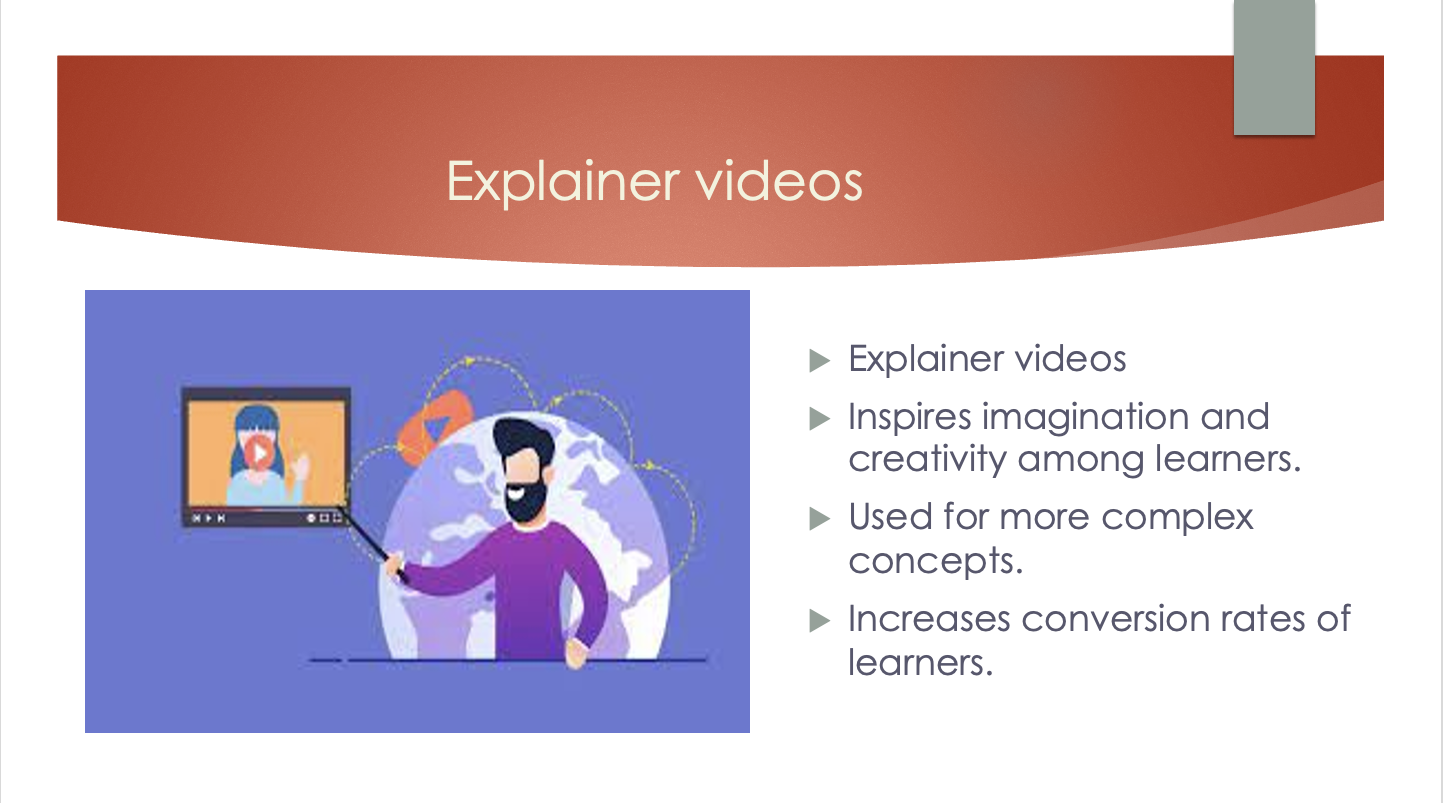 Explainer videos
Explainer videos
Explainer videos help learners develop imagination and inspire them to be more creative (O’Doherty, 2020). They are primarily used in explaining more complex concepts as it helps learners to understand challenging courses and retain the acquired information. However, they are also used to engage learners with complex themes and encourage their engagement with the content. This is mainly because it plays a critical role in stimulating learners’ cognitive process of thinking and reasoning.
They play a critical role to learners as they grab their attention with funny characters stimulate their imagination and creativity with fresh and new ideas. It also increases the conversion rates of the learners, which will boost their performances significantly. It also teaches learners how to interact with each other in a social environment, enabling them to express themselves freely.
Slide 5
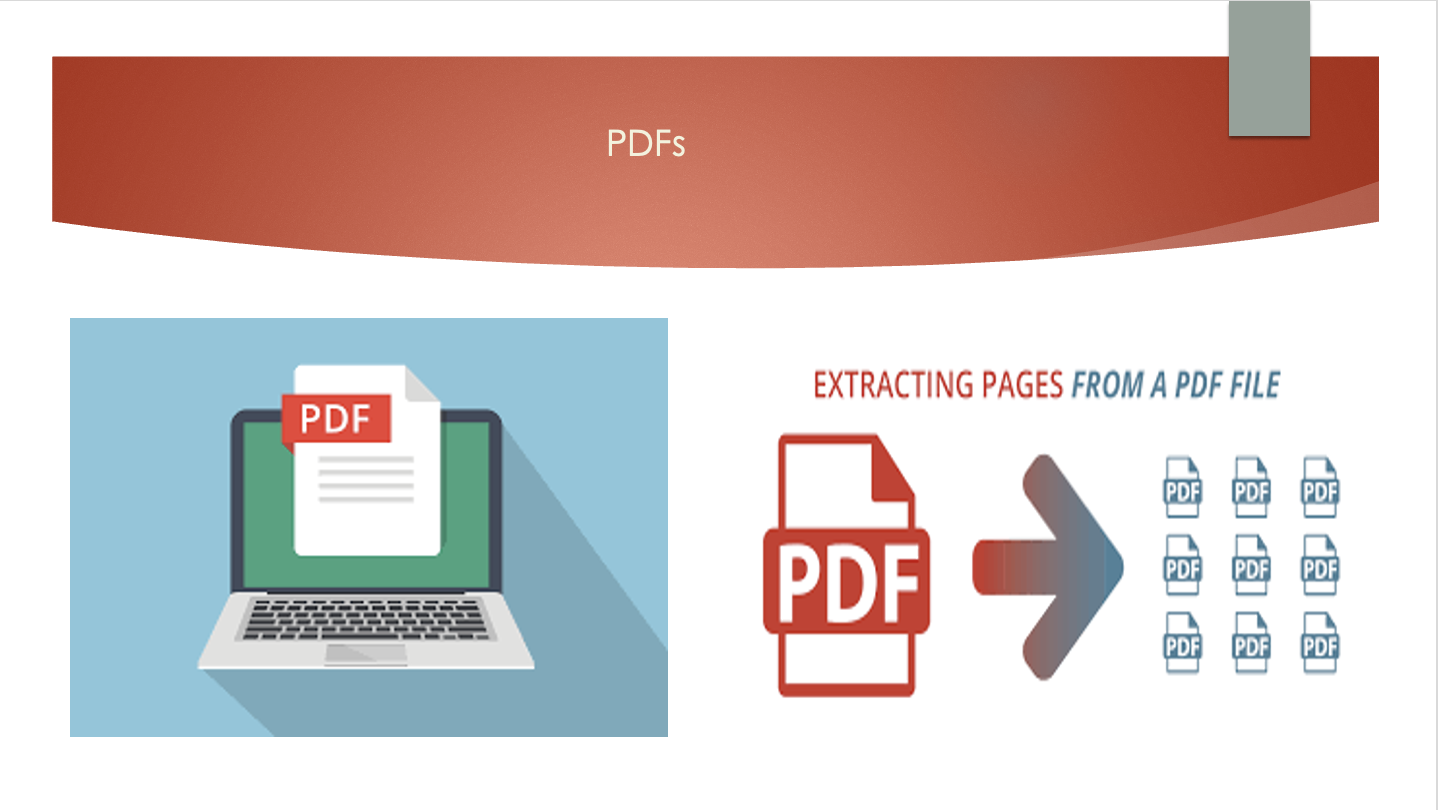 PDFs
PDFs
PDFs are file formats used to present documents independently that are distinct from that of the operating software, application software, and hardware. They are also reliable means that learners can use to exchange electronic documents. They are mainly used for digital file organization and when merging tons of similar documents into a single file. This is mainly because they are easier to retrieve when learners use them.
PDFs enable learners to organize their digital files safely and orderly (Camel et al., 2020). Their documents are secure and convenient as they share with their classmates and tutors anytime. It also gives learners the ability to make changes to PDF files when using their smartphones.
Slide 6
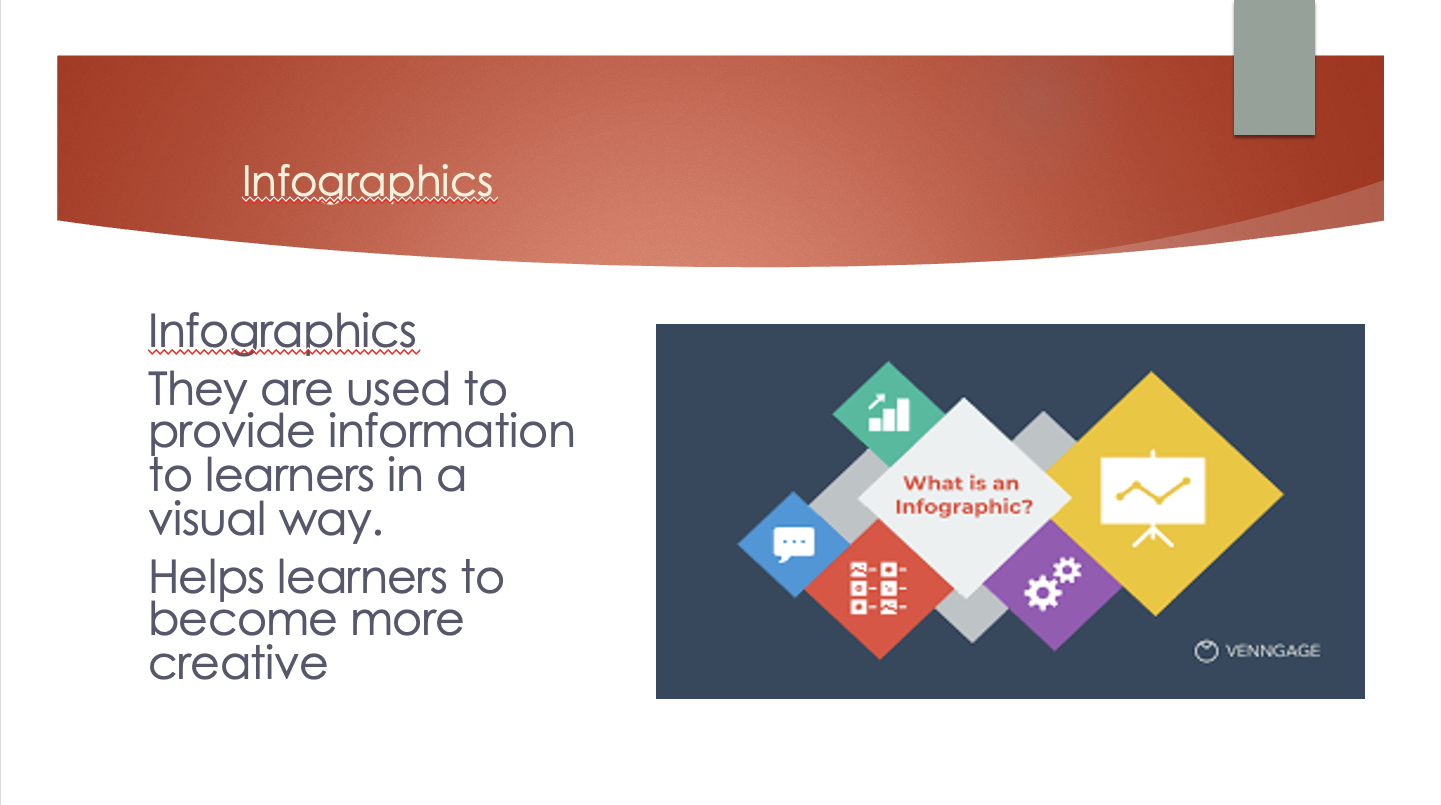 Infographics
Infographics
According to Chicca and Chunta (2020), Infographics are used to provide information to learners in a visual way. They are designed to provide learners with various visuals such as graphs, texts, pictures and diagrams, among others. They are applied when conveying complex data in simple visual formats. They are also used when telling stories as it enables learners to comprehend information accurately and quickly.
Infographics help learners be more creative as they can also find reliable sources of information (Dehghani et al., 2020). It also helps them comprehend their courses as it increases the exposure of their content. It also enables learners to process information in ways that are more accessible to them as it provides images or words that play a critical role in grabbing their attention.
Slide 7
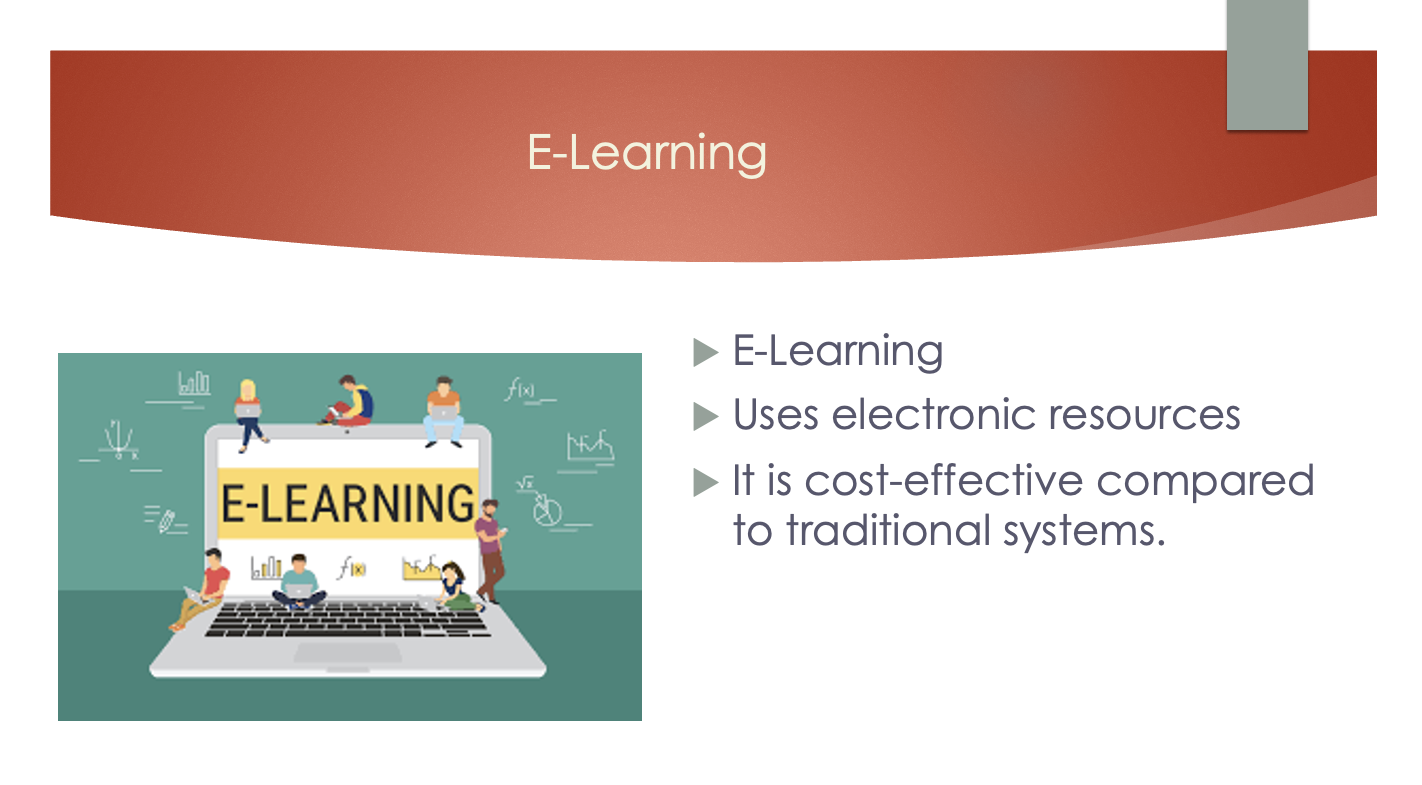 E-learning
E-learning
E-learning is used to teach learners with the help of electronic resources. When learners are mobile or large numbers, it can be used to ensure that all learners receive the same syllabus or study material throughout. E-learning is more cost-effective than traditional learning systems (Sweta, 2021).
It increases the scalability of learners while also enabling them to adjust their needs. It is also more flexible to learners in terms of place and time which can also take advantage of instant career advancement. Learners will also receive the same study materials with their peers through e-learning.
Slide 8
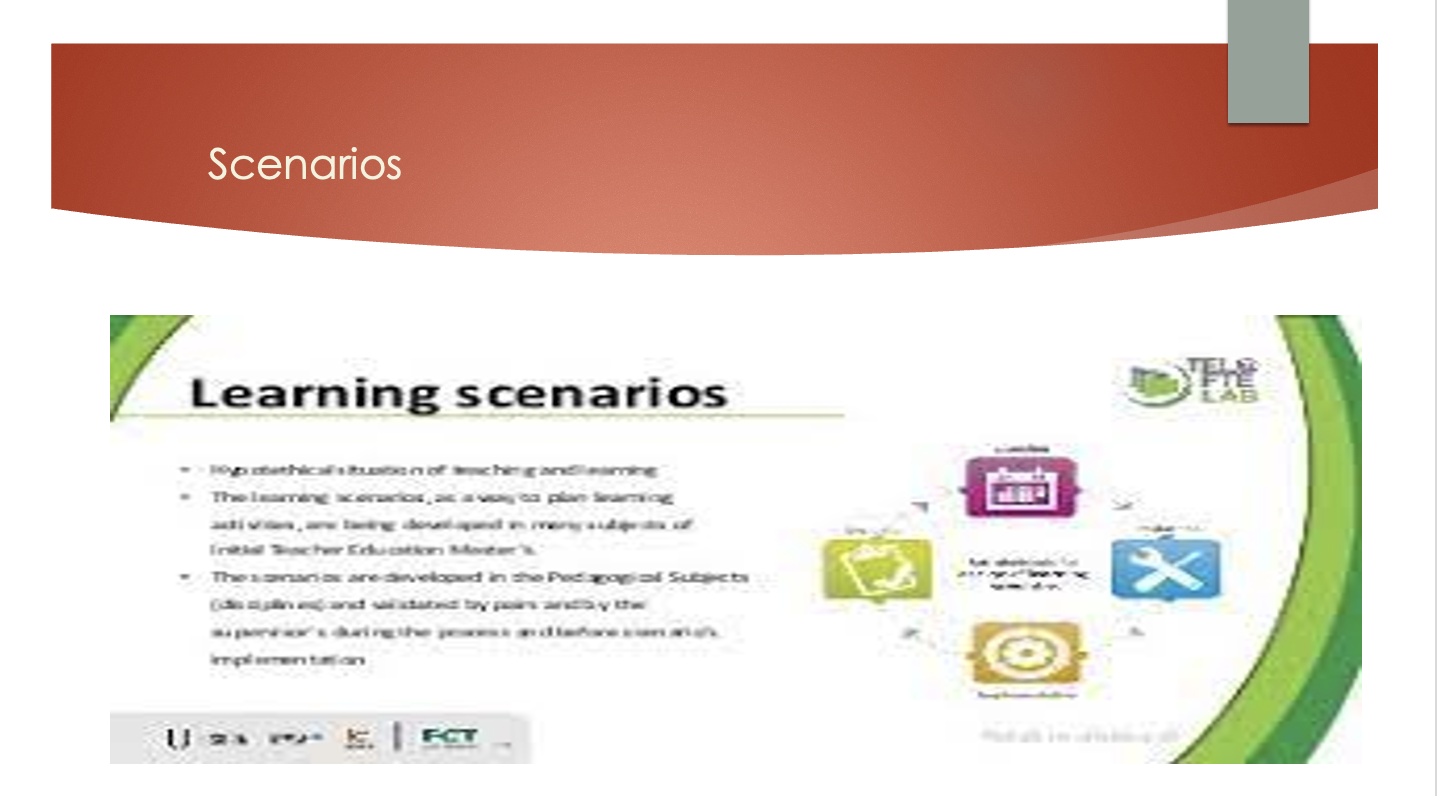 Scenarios
Scenarios
Scenarios are used to describe the learning situation independently of the pedagogical approach (Gasteiger et al., 2019). They have used stories with characters and situations, which are also accompanied by questions targeted towards the learner. It uses interactive situations to support active learning strategies of the learners, which are often cased or problem-based learning.
It helps boost the learner’s success rate as it helps them in their subject matter, making them face problems or situations they would encounter in their real life. It also improves learners’ confidence while creating authentic experiences in their lives.
4 Attributes to consider when choosing the right digital learning content to maximize learner engagement and ensure that the content meets the identified learning need (AC 2.2).
Slide 9
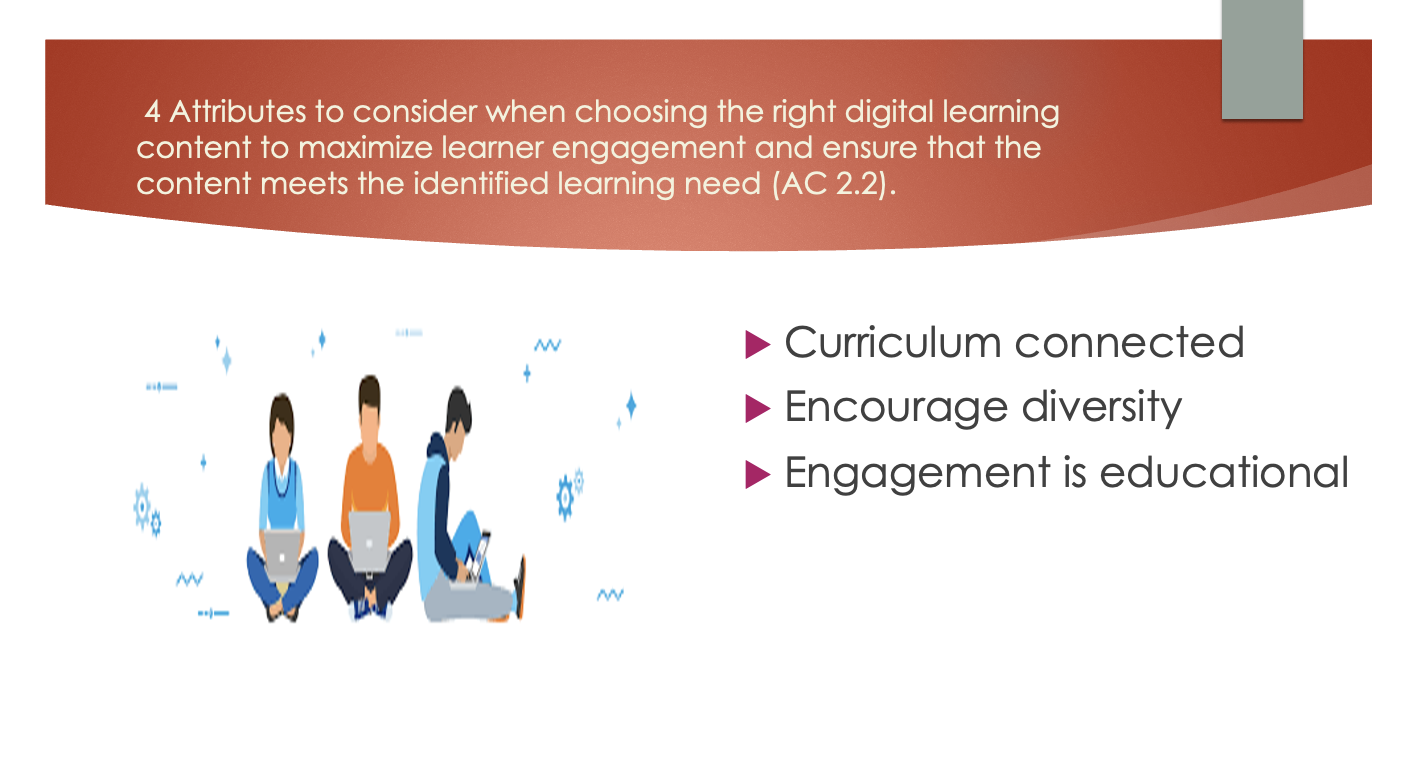 Curriculum is connected
Curriculum is connected
The right digital content should incorporate value into learners’ learning experience by having a clear connection to their curriculum. Therefore, the digital content should be connected to the curriculum and learning standards of the learners. It should also provide images that can trigger questions that enable learners to explore biomes to learn more. Additionally, it should also enable learners to dig deeper while cultivating their curiosity to develop their research skills.
I review the digital content to ensure it is connected to the learner’s curriculum and the learning standards. In addition, I will assess the digital content to ensure that it has a deeper connection with the learner’s curriculum guides and aligns with their standards.
Encourages diversity
The digital learning content should also include a diversity of the learner’s world to interact with them. Therefore, through the digital content, learners should always visualize themselves, their surrounding community, and the diversity of their world represented in the digital content (Yurkofsk et al. 2019).
I will ensure that the digital learning content meets the learning need by looking at the footage that has been selected by the digital tool. It should contain a broad representation of colours, gender, and ethnicities.
Engagement is educational
Engagement of the digital learning content with the learner should also be a significant priority as it plays a critical role in increasing their attention (Yu, Gao and Wang, 2020). It should be able to capture the learner’s attention and curiosity. Additionally, it should also be connected to the learning objective. The digital content should allow the fun to the learner, but it should play a critical role in their learning to increase their learning experience.
I would ensure that the digital content meets the learning need by seeking fun digital tools for learners and questioning the connection between engagement and their learning objective. In addition, the digital content should be able to add value to the student.
References
Camel, V., Maillard, M., Descharles, N., Le Roux, E., Cladière, M. and Billault, I., 2020. Open Digital Educational Resources for Self-Training Chemistry Lab Safety Rules. Journal of Chemical Education, 98(1), pp.208-217.
Caputo, F., Garcia-Perez, A., Cillo, V. and Giacosa, E., 2019. A knowledge-based view of people and technology: directions for a value co-creation-based learning organisation. Journal of Knowledge Management, 23(7), pp.1314-1334.
Chicca, J. and Chunta, K., 2020. Engaging Students with Visual Stories: Using Infographics in Nursing Education. Teaching and Learning in Nursing, 15(1), pp.32-36.
Dehghani, M., Mohammadhasani, N., Hoseinzade Ghalevandi, M. and Azimi, E., 2020. Applying AR-based infographics to enhance learning of the heart and cardiac cycle in biology class. Interactive Learning Environments, pp.1-16.
Gasteiger, H., Bruns, J., Benz, C., Brunner, E. and Sprenger, P., 2019. Mathematical pedagogical content knowledge of early childhood teachers: a standardized situation-related measurement approach. ZDM, 52(2), pp.193-205.
O’Doherty, D., 2020. The Leviathan of Rationality: Using Film to Develop Creativity and Imagination in Management Learning and Education. Academy of Management Learning & Education, 19(3), pp.366-384.
Odinokaya, M., Krepkaia, T., Sheredekina, O. and Bernavskaya, M., 2019. The Culture of Professional Self-Realization as a Fundamental Factor of Students’ Internet Communication in the Modern Educational Environment of Higher Education. Education Sciences, 9(3), p.187.
Regan, P. and Jesse, J., 2018. Ethical challenges of edtech, big data and personalized learning: twenty-first century student sorting and tracking. Ethics and Information Technology, 21(3), pp.167-179.
Stenman, S. and Pettersson, F., 2020. Remote teaching for equal and inclusive education in rural areas? An analysis of teachers’ perspectives on remote teaching. The International Journal of Information and Learning Technology, 37(3), pp.87-98.
Sweta, S., 2021. Educational Data Mining in E-Learning System. Modern Approach to Educational Data Mining and Its Applications, pp.1-12.
Yu, Z., Gao, M. and Wang, L., 2020. The Effect of Educational Games on Learning Outcomes, Student Motivation, Engagement and Satisfaction. Journal of Educational Computing Research, 59(3), pp.522-546.
Yurkofsky, M., Blum-Smith, S. and Brennan, K., 2019. Expanding outcomes: Exploring varied conceptions of teacher learning in an online professional development experience. Teaching and Teacher Education, 82, pp.1-13.
Task 2 – “Showcasing” digital facilitated learning using a live online learning system (1000words)
Part B – A written response to the following Assessment Criteria
Functionalities, strengths and weaknesses of podcasts and video-based learning as live online learning delivery methods (AC 3.1)
Podcasts
Podcasts are the most effective and efficient way to teach new content to learners as they can listen independently (Oslawski-Lopez and Kordsmeier, 2021). It also frees up more time in the classroom for more other activities. It is practical, as learners can use podcasts to absorb more information, go through questions, or even participate in group discussions. Besides teaching, it can also improve the learners’ learning skills in the classroom (Besser et al., 2021). They are also used to communicate with learners outside of the traditional classes. Podcasts can also enhance comprehension, creative sources of information, stimulation of creative thinking, and as a unique storytelling medium that enhances better engagement.
Strengths of Podcast
Flexible availability
Podcasts are portable and convenient as they can be downloaded to mobile phones enabling learners to access their educational resources anytime and anywhere (Shiang et al. 2021). It also facilitates creating personal podcasts that can only be accessible by selected learners.
Learners created content
According to Yeh et al. (2021), Learners can also create their podcasts, including discussions, presentations, or other questions. It enables learners to take advantage of their education while encouraging engagement in the learning material.
Learners listen for longer than they watch or read
It plays a critical role in capturing the attention of readers. They are more convenient, and learners can actively listen to podcasts at their convenient times.
Weaknesses of podcasts
Time-consuming
Podcasts are public spaces in which many users publish their data. Therefore, instructors will have to wait for their won podcasts to be verified. It is also time-consuming for larger files.
Not Searchable
It isn’t easy to search podcasts within the available search engines on the internet. This could be a significant weakness, especially for individuals who prefer to gather their podcasts by scanning them through texts.
Online delivery Course through videos
Delivering the learning activities through videos is critical in creating engagement while keeping learning sessions more interactive. They are also more effective as it boosts the learning speed of learners. In addition, they are used to create more engaging sensory experiences among learners as it stimulates their cognitive processes of thinking and reasoning.
Strengths
Video-based learning is not only cost-effective, but they play a critical role in increasing learner participation and engagement (Ninaus et al., 2019). It also provides a practical and more straightforward learning experience.
Weaknesses
Video-based learning has defaulted as it promotes individualism, making learning more difficult. They are also more expensive and time-consuming.
Differences between online learning activity and face to face learning as well its implications (AC 3.2)
Learning environment
Live online learning activity allows learners to undertake their learning activities at any place that suits their needs (Berry and Hughes, 2019). It does not involve a physical instructor, but rather, learners engage in the online learning activities by themselves. Face to the face learning activity, on the other hand, is mainly conducted within a fixed schedule in a class. The classroom setting also requires the availability of a physical facilitator who will be guiding learners in their discussion, involvement and interaction.
Type of learning content
Online learning activities are more interactive with a wide variety of training. The learning content can be available on online discussion boards, digital textbooks, interactive quizzes and other learning modules. Online learning is also more accessible and interactive due to several digital learning platforms that make the learning activity more engaging. On the other hand, face to face learning activities mainly involves traditional learning materials such as lecture notes and textbooks.
Facilitators
Online learning provides the required effectiveness to facilitators, thus maximising their potential for individual learning styles and curves. It is also cost-effective as it reduces printing costs and travel fees.
Learners
Online learning has played a critical role in helping learners become more independent. Digital tools have been exposing learners to opportunities that will enable them to explore new learning platforms and applications to develop new skills and capabilities. While learners have the freedom to work at their pace, online learning experiences also play a critical role in helping them to build a better understanding with their facilitators.
Learning administration
Online learning has played a critical role in the development of institutional learning. It has enabled learning administration to train online facilitators in best practices. It also helps to learn administration to identify existing policies that might be needed to adjust the learning progress of learners.
Facilitation skills required to facilitate live online learning (AC3.3)
Facilitation skills
Clear communication
Live online learning requires clear communication to ensure that all participants are on the same page during discussions. It ensures that instructions for activities are more precise with a shared understanding of the end goal. Live online learning can be more accessible when the facilitator plays a critical role in establishing a shared understanding of shared ideas.
Active listening
Active listening is another crucial skill necessary for successful online learning. It promotes mindful thinking and enables learners to engage with peers and facilitators actively. It plays a critical role in ensuring clarity of understanding during group discussions. Active listening also enables listeners to acquire and absorb more knowledge from the facilitator without missing important information.
Creating focus
To ensure that live online learning is productive, facilitators should focus on the learners during their meetings. Focus within the live online learning can be enhanced by removing distractions that might deviate learners’ attention. This can be improved by creating ground rules such as banning phones or learners that might distract learners during the online learning session.
Active listening skills
Active listening skills involves listening to the facilitator with all senses. Active listening can be achieved by facing the facilitator and maintaining eye contact, being attentive and relaxed, keeping an open mind, listening to the facilitator’s words and trying to picture them, and listening keenly without imposing any solutions. It can also be enhanced by giving the speaker or facilitator regular feedback.
Active listening is instrumental in learning. It will also enable me to build a relationship to engage with peers who view me as more open and interested. It also plays a critical role in building trust and understanding with other individuals’ feelings and situations. Additionally, it also plays a critical role in offering support and empathy.
References
Berry, G. and Hughes, H., 2019. Integrating Work–Life Balance with 24/7 Information and Communication Technologies: The Experience of Adult Students With Online Learning. American Journal of Distance Education, 34(2), pp.91-105.
Besser, E., Blackwell, L. and Saenz, M., 2021. Engaging Students Through Educational Podcasting: Three Stories of Implementation. Technology, Knowledge and Learning,.
Ninaus, M., Greipl, S., Kiili, K., Lindstedt, A., Huber, S., Klein, E., Karnath, H. and Moeller, K., 2019. Increased emotional engagement in game-based learning – A machine learning approach on facial emotion detection data. Computers & Education, 142, p.103641.
Oslawski-Lopez, J. and Kordsmeier, G., 2021. “Being Able to Listen Makes Me Feel More Engaged”: Best Practices for Using Podcasts as Readings. Teaching Sociology, 49(4), pp.335-347.
Shiang, T., Cerniglia, C., Lin, H. and Lo, H., 2021. Radiology podcasting as a model for asynchronous remote learning in the COVID-19 era. Clinical Imaging, 71, pp.147-154.
Yeh, H., Chang, W., Chen, H. and Heng, L., 2021. Effects of podcast-making on college students’ English speaking skills in higher education. Educational Technology Research and Development, 69(5), pp.2845-2867.



